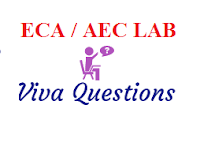Home / Lab Viva / MPMC
Lab
1.What is a Microprocessor?
It is a CPU fabricated on a
single chip, program-controlled device, which fetches the instructions from
memory, decodes and executes the instructions.
2. Define bit, byte and word.
Bit is either 0 or 1.
Byte is group of 8 bits.
Word is group of 16 bits.
3.What are the different
functional units in 8086?
2 units-Bus Interface Unit
(BIU) and Execution unit (EU)
4. What is the function of BIU
?
It is used to generate the
20-bit physical address and is responsible for performing all external bus
operations.
5. What is the function of EU?
Execution Unit receives
program codes and data from BIU, executes these instructions and store the
result.
6. What is the maximum size of
segment in 8086 microprocessor?
64KB.
7. What is general purpose
registers in 8086?
There are 4 general purpose
registers are there.
AX-ACCUMULATOR
BX- BASE
CX- COUNT
DX-DATA (Extended
accumulator)
8. What are the functions of
General purpose Registers?
AX register as 16-bit
accumulator, stores all arithmetic and logical operation's results.
BX register is used as an
offset address Storage.
CX register is used as
counter. Especially used in loop, shift, rotate instructions.
DX register is used in port
operations (IN and OUT)
9. What is special purpose
registers in 8086?
CS- CODE SEGMENT
DS-DATA SEGMENT
ES-EXTRA SEGMENT
SS-STACK SEGMENT
BP-BASE POINTER
IP-INSTRUCTION POINTER
SP- STACK POINTER
SI-SOURCE INDEX
DI-DESTINATION INDEX
FLAG REGISTER
10. What are the functions of
base Registers?
CS stores program code,
DS stores data
ES sores extra data
SS stores stack data.
11. Name the pin in 8086
microprocessor that is used for selecting mode of operation?
29th pin-MN/MX'
If MN/MX'=0 then maximum
mode is selected.
MN/MX'=1 then minimum mode
is selected.
12. What is Segment address in
8086?
The part of the segment
starting address stored in a segment register is called the segment address.
13. What are the flags in 8086?
In 8086, 9 flags are there.
Out of 9, 6 are conditional (status) flags and 3 control flags.
Conditional (status) flags:
Carry flag (CF), Parity
flag (PF), Auxiliary carry flag (CF), Zero flag (ZF), Overflow flag (OF), and
Sign flag(SF)
Control flags:
Trap flag (TF), Direction
flag (DF), Interrupt flag (IF),
14. What is Tri-state logic?
Three Logic Levels are used
and they are High (logic 1), Low(logic 0), High impedance(Z) state. The high
and low are normal logic levels & high impedance state is electrical open
circuit conditions.
15. What is system bus?
Group of address, data and
control buses.
Address bus: carry
the Address to the memory to fetch either Instruction or Data.
Data bus: carry
the Data from the memory.
Control bus: carry the
Control signals like RD/WR, reset, ready etc.
16. What is the difference
between Maskable interrupts and Non-Maskable interrupts?
An interrupt that can be
turned off by the programmer is known as Maskable interrupt.
An interrupt which can be
never be turned off (i.e. disabled) is known as Non-Maskable interrupt.
17. What are the different
types of Addressing Modes?
There are 12 different
types of Addressing Modes. They are:-
1 Immediate:-The Immediate
data is a part of instruction.
2. Direct:-A 16-bit memory
address (offset) is directly specified in the instruction as a part of it.
3. Register:-Data is stored
in a register.
4. Register Indirect:-The
address of the memory location which contains data or operand is determined in
an indirect way.
5. Indexed:-offset of the
operand is stored in one of the index registers.
6. Register Relative:-The
data is available at an effective address formed by adding an 8-bit or 16-bit
displacement with the content of any one of the registers BX,BP,SI and DI in
the default (either DS or ES) segment.
7. Based Indexed:-The
effective address of the data is formed, in this addressing mode,by adding
content of a base register to the content of an index register.
8. Relative Based Indexed:-
The effective address is formed by adding an 8 or 16-bit displacement with the
sum of contents of any one of the base registers and any one of the index
registers, in the default segment.
9. Intrasegment Direct
Mode:-In this mode, the address to which the control is to bve transferred lies
in the segment in which the control transfer instruction lies and appears
directly in the instruction as an immediate displacement value.
10. Intrasegment Indirect
Mode:-In this mode, the displacement to which the control is to be transferred,
is in the same segment in which the control transfer instruction lies, but it
is passed to the instruction indirectly.
11. Intersegment Direct:-In
this mode, the address to which the control is to be transferred is in a
different segment.
12. Intersegment
Indirect:-In this mode, the address to which the control is to be transferred
lies in a different segment and it is passed to the instruction indirectly
sequentially.
18. What is baud rate?
The baud rate is the rate
at which the serial data are transmitted. Units- symbols per second.
19. What is a port?
The port is a buffered I/O,
which is used to hold the data transmitted from the processor to I/O device or
vice-versa.
20. What is 8255?
It is PPI- Programmable
Peripheral Interface. it is used to connect
I/O devices to microprocessor and supports parallel communication.
Tags:
Microcontroller and microprocessors lab viva questions with answers, MPMC Lab
viva questions, Microprocessors and Interfacing Lab viva questions with
answers, MPI lab viva questions.




